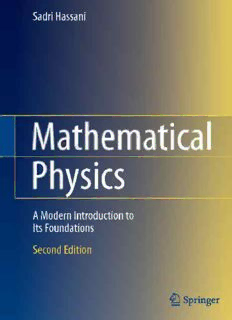Table Of ContentMathematical Physics
Sadri Hassani
Mathematical
Physics
A Modern Introduction to
Its Foundations
Second Edition
SadriHassani
DepartmentofPhysics
IllinoisStateUniversity
Normal,Illinois,USA
ISBN978-3-319-01194-3 ISBN978-3-319-01195-0(eBook)
DOI10.1007/978-3-319-01195-0
SpringerChamHeidelbergNewYorkDordrechtLondon
LibraryofCongressControlNumber:2013945405
©SpringerInternationalPublishingSwitzerland1999,2013
Thisworkissubjecttocopyright.AllrightsarereservedbythePublisher,whetherthewhole
orpartofthematerialisconcerned,specificallytherightsoftranslation,reprinting,reuseof
illustrations,recitation,broadcasting,reproductiononmicrofilmsorinanyotherphysicalway,
andtransmissionorinformationstorageandretrieval,electronicadaptation,computersoftware,
orbysimilarordissimilarmethodologynowknownorhereafterdeveloped.Exemptedfromthis
legalreservationarebriefexcerptsinconnectionwithreviewsorscholarlyanalysisormaterial
suppliedspecificallyforthepurposeofbeingenteredandexecutedonacomputersystem,for
exclusiveusebythepurchaserofthework.Duplicationofthispublicationorpartsthereofis
permittedonlyundertheprovisionsoftheCopyrightLawofthePublisher’slocation,inits
currentversion,andpermissionforusemustalwaysbeobtainedfromSpringer.Permissions
forusemaybeobtainedthroughRightsLinkattheCopyrightClearanceCenter.Violationsare
liabletoprosecutionundertherespectiveCopyrightLaw.
Theuseofgeneraldescriptivenames,registerednames,trademarks,servicemarks,etc.inthis
publicationdoesnotimply,evenintheabsenceofaspecificstatement,thatsuchnamesare
exemptfromtherelevantprotectivelawsandregulationsandthereforefreeforgeneraluse.
Whiletheadviceandinformationinthisbookarebelievedtobetrueandaccurateatthedateof
publication,neithertheauthorsnortheeditorsnorthepublishercanacceptanylegalresponsi-
bilityforanyerrorsoromissionsthatmaybemade.Thepublishermakesnowarranty,express
orimplied,withrespecttothematerialcontainedherein.
Printedonacid-freepaper
SpringerispartofSpringerScience+BusinessMedia(www.springer.com)
Tomywife,Sarah,
andtomychildren,
DaneArashand DaisyBita
Preface to Second Edition
Basedonmyownexperienceofteachingfromthefirstedition,andmoreim-
portantlybasedonthecommentsoftheadoptersandreaders,Ihavemade
some significant changes to the new edition of the book: Part I is substan-
tiallyrewritten,PartVIIIhasbeenchangedtoincorporateCliffordalgebras,
Part IX now includes the representation of Clifford algebras, and the new
PartXdiscussestheimportanttopicoffiberbundles.
I felt that a short section on algebra did not do justice to such an im-
portanttopic.Therefore,Iexpandeditintoacomprehensivechapterdealing
withthebasicpropertiesofalgebrasandtheirclassification.Thisrequireda
rewritingofthechapteronoperatoralgebras,includingtheintroductionofa
sectionontherepresentationofalgebrasingeneral.Thechapteronspectral
decompositionunderwentacompleteoverhaul,asaresultofwhichthetopic
is nowmorecohesiveandtheproofsmorerigorous andilluminating.This
entailedseparatetreatmentsofthespectraldecompositiontheoremforreal
andcomplexvectorspaces.
Theinnerproductofrelativityisnon-Euclidean.Therefore,inthediscus-
sionof tensors,I haveexplicitlyexpandedontheindefiniteinnerproducts
andintroducedabriefdiscussionofthesubspacesofanon-Euclidean(the
so-calledsemi-Riemannianorpseudo-Riemannian)vectorspace.Thisinner
product,combinedwiththenotionofalgebra,leadsnaturallytoCliffordal-
gebras,thetopicofthesecondchapterofPartVIII.Motivatingthesubject
by introducing the Dirac equation, the chapter discusses the general prop-
ertiesofCliffordalgebrasinsomedetailandcompletelyclassifiestheClif-
fordalgebras Cν(R),thegeneralizationofthealgebra C1(R),theClifford
μ 3
algebra of the Minkowski space. The representation of Clifford algebras,
includingatreatmentofspinors,istakenupinPartIX,afteradiscussionof
therepresentationofLieGroupsandLiealgebras.
Fiber bundles have become a significant part of the lore of fundamen-
tal theoretical physics. The natural setting of gauge theories, essential in
describingelectroweakandstronginteractions,isfiberbundles.Moreover,
differentialgeometry,indispensableinthetreatmentofgravity,ismostele-
gantlytreatedintermsoffiberbundles.Chapter34introducesfiberbundles
andtheircomplementarynotionofconnection,andthecurvatureformaris-
ingfromthelatter.Chapter35ongaugetheoriesmakescontactwithphysics
andshowshowconnectionisrelatedtopotentialsandcurvaturetofields.It
also constructs the most general gauge-invariant Lagrangian, including its
local expression (the expression involving coordinate charts introduced on
theunderlyingmanifold),whichistheformusedbyphysicists.InChap.36,
vii
viii PrefacetoSecondEdition
by introducing vector bundles and linear connections, the stage becomes
readyfortheintroductionofcurvaturetensorandtorsion,twomajorplay-
ersindifferentialgeometry.Thisapproachtodifferentialgeometryviafiber
bundles is, in my opinion, the most elegant and intuitive approach, which
avoidstheadhocintroductionofcovariantderivative.Continuingwithdif-
ferential geometry, Chap. 37 incorporates the notion of inner product and
metricintoit,comingupwiththemetricconnection,soessentialinthegen-
eraltheoryofrelativity.
Allthesechangesandadditionsrequiredcertainomissions.Iwascareful
nottobreakthecontinuityandrigorofthebookwhenomittingtopics.Since
noneofthediscussionsofnumericalanalysiswasusedanywhereelseinthe
book, these were the first casualties. A few mathematical treatments that
weretoodry,technical,andnotinspiringwerealsoremovedfromthenew
edition. However, I provided references in which the reader can find these
missingdetails.Theonlycasualtyofthiskindofomissionwasthediscus-
sionleadingtothespectraldecompositiontheoremforcompactoperatorsin
Chap.17.
Aside from the above changes,I have also altered the style of the book
considerably. Now all mathematical statements—theorems, propositions,
corollaries,definitions,remarks,etc.—andexamplesarenumberedconsec-
utively without regard to their types. This makes finding those statements
or examples considerably easier. I have also placed important mathemat-
ical statements in boxes which are more visible as they have dark back-
grounds. Additionally,I haveincreased the numberof marginal notes,and
addedmanymoreentriestotheindex.
Many readers and adopters provided invaluable feedback, both in spot-
ting typos and in clarifying vague and even erroneous statements of the
book. I would like to acknowledge the contribution of the following peo-
pletothecorrectionoferrorsandtheclarificationofconcepts:SylvioAn-
drade,SalarBaher,RafaelBenguria,JimBogan,JorunBomert,JohnChaf-
fer, Demetris Charalambous, Robert Gooding, Paul Haines, Carl Helrich,
RayJensen,Jin-WookJung,DavidKastor,FredKeil,MikeLieber,ArtLind,
Gary Miller, John Morgan, Thomas Schaefer,Hossein Shojaie,Shreenivas
Somayaji,WernerTimmermann,JohanWild,BradleyWogsland,andFang
Wu.AsmuchasItriedtokeeparecordofindividualswhogavemefeed-
backonthefirstedition,fourteenyearsisalongtime,andImayhaveomit-
tedsomenamesfromthelistabove.Tothosepeople,Isincerelyapologize.
Needless to say, any remaining errors in this new edition is solely my re-
sponsibility,andasalways,I’llgreatlyappreciateitifthereaderscontinue
pointingthemouttome.
I consulted the following three excellent books to a great extent for the
additionand/orchangesinthesecondedition:
Greub,W.,LinearAlgebra,4thed.,Springer-Verlag,Berlin,1975.
Greub,W.,MultilinearAlgebra,2nded.,Springer-Verlag,Berlin,1978.
Kobayashi, S., and K. Nomizu, Foundations of Differential Geometry,
vol.1,Wiley,NewYork,1963.
Maury Solomon, my editor at Springer, was immeasurably patient and
cooperative on a project that has been long overdue. Aldo Rampioni has
PrefacetoSecondEdition ix
been extremely helpful and cooperative as he took over the editorship of
the project. My sincere thanks go to both of them. Finally, I would like to
thank my wife Sarah for her unwavering forbearance and encouragement
throughoutthelong-drawn-outwritingofthenewedition.
Normal,IL,USA SadriHassani
November,2012
Preface to First Edition
“Ich kann es nun einmal nicht lassen, in diesem Drama von Mathematik und
Physik—die sich im Dunkeln befruchten, aber von Angesicht zu Angesicht so
gerneeinanderverkennenundverleugnen—dieRolledes(wieichgenügsamer-
fuhr,oftunerwünschten)Botenzuspielen.”
HermannWeyl
ItissaidthatmathematicsisthelanguageofNature.Ifso,thenphysics
is its poetry. Nature started to whisper into our ears when Egyptians and
Babylonians were compelled to invent and use mathematics in their day-
to-day activities. The faint geometric and arithmetical pidgin of over four
thousand years ago, suitable for rudimentary conversations with nature as
applied to simple landscaping, has turned into a sophisticated language in
whichtheheartofmatterisarticulated.
The interplay between mathematics and physics needs no emphasis.
What may need to be emphasized is that mathematics is not merely a tool
with which the presentation of physics is facilitated, but the only medium
in which physics can survive. Just as language is the means by which hu-
mans can express their thoughts and without which they lose their unique
identity, mathematics is the only language through which physics can ex-
press itself and without which it loses its identity. And just as language is
perfectedduetoitsconstantusage,mathematicsdevelopsinthemostdra-
matic way because of its usage in physics. The quotation by Weyl above,
anapproximationtowhosetranslationis“Inthisdramaofmathematicsand
physics—whichfertilizeeachotherinthedark,butwhichprefertodenyand
misconstrue each other face to face—I cannot, however, resist playing the
role of a messenger, albeit, as I have abundantly learned, often an unwel-
come one,” is a perfect description of the natural intimacy between what
mathematiciansandphysicistsdo,andtheunnaturalestrangementbetween
thetwocamps.Someofthemostbeautifulmathematicshasbeenmotivated
byphysics(differentialequationsbyNewtonianmechanics,differentialge-
ometry by general relativity, and operator theory by quantum mechanics),
andsomeofthemostfundamentalphysicshasbeenexpressedinthemost
beautiful poetry of mathematics (mechanics in symplectic geometry, and
fundamentalforcesinLiegrouptheory).
Idonotwanttogivetheimpressionthatmathematicsandphysicscannot
developindependently.Onthecontrary,itispreciselytheindependenceof
each discipline that reinforces not only itself, but the other discipline as
well—justasthestudyofthegrammarofalanguageimprovesitsusageand
viceversa.However,themosteffectivemeansbywhichthetwocampscan
xi
xii PrefacetoFirstEdition
accomplish great success is through an intense dialogue. Fortunately, with
theadventofgaugeandstringtheoriesofparticlephysics,suchadialogue
has been reestablished between physics and mathematics after a relatively
longlull.
LevelandPhilosophyofPresentation
This isabookfor physicsstudentsinterestedinthemathematicstheyuse.
Itisalsoabookformathematicsstudentswhowishtoseesomeoftheab-
stract ideas with which they are familiar come alive in an applied setting.
Thelevelofpresentationisthatofanadvancedundergraduateorbeginning
graduatecourse(orsequenceofcourses)traditionallycalled“Mathematical
MethodsofPhysics”orsomevariationthereof.Unlikemostexistingmath-
ematical physics books intended for the same audience, which are usually
lexicographiccollectionsoffactsaboutthediagonalizationofmatrices,ten-
soranalysis,Legendrepolynomials,contourintegration,etc.,withlittleem-
phasisonformalandsystematicdevelopmentoftopics,thisbookattempts
tostrikeabalancebetweenformalismandapplication,betweentheabstract
andtheconcrete.
I have tried to include as much of the essential formalism as is neces-
sarytorenderthebookoptimallycoherentandself-contained.Thisentails
statingandprovingalargenumberoftheorems,propositions,lemmas,and
corollaries. The benefit of such an approach is that the student will recog-
nizeclearlyboththepowerandthelimitationofamathematicalideaused
inphysics.Thereisatendencyonthepartofthenovicetouniversalizethe
mathematicalmethodsandideasencounteredinphysicscoursesbecausethe
limitationsofthesemethodsandideasarenotclearlypointedout.
Thereisagreatdealoffreedominthetopicsandthelevelofpresentation
that instructors can choose from this book. My experience has shown that
PartsI,II,III,Chap.12,selectedsectionsofChap.13,andselectedsections
orexamplesofChap.19(oralargesubsetofallthis)willbeareasonable
coursecontentforadvancedundergraduates.IfoneaddsChaps.14and20,
as well as selected topics from Chaps. 21 and 22, one can design a course
suitableforfirst-yeargraduatestudents.Byjudiciouschoiceoftopicsfrom
Parts VII and VIII, the instructor can bring the content of the course to a
moremodernsetting.Dependingonthesophisticationofthestudents,this
canbedoneeitherinthefirstyearorthesecondyearofgraduateschool.
Features
Tobetterunderstandtheorems,propositions,andsoforth,studentsneedto
seetheminaction.Thereareover350worked-outexamplesandover850
problems(manywithdetailedhints)inthisbook,providingavastarenain
which students can watch the formalism unfold. The philosophy underly-
ingthisabundancecanbesummarizedas“Anexampleisworthathousand
wordsofexplanation.”Thus,wheneverastatementisintrinsicallyvagueor
Description:The goal of this book is to expose the reader to the indispensable role that mathematics---often very abstract---plays in modern physics. Starting with the notion of vector spaces, the first half of the book develops topics as diverse as algebras, classical orthogonal polynomials, Fourier analysis,

